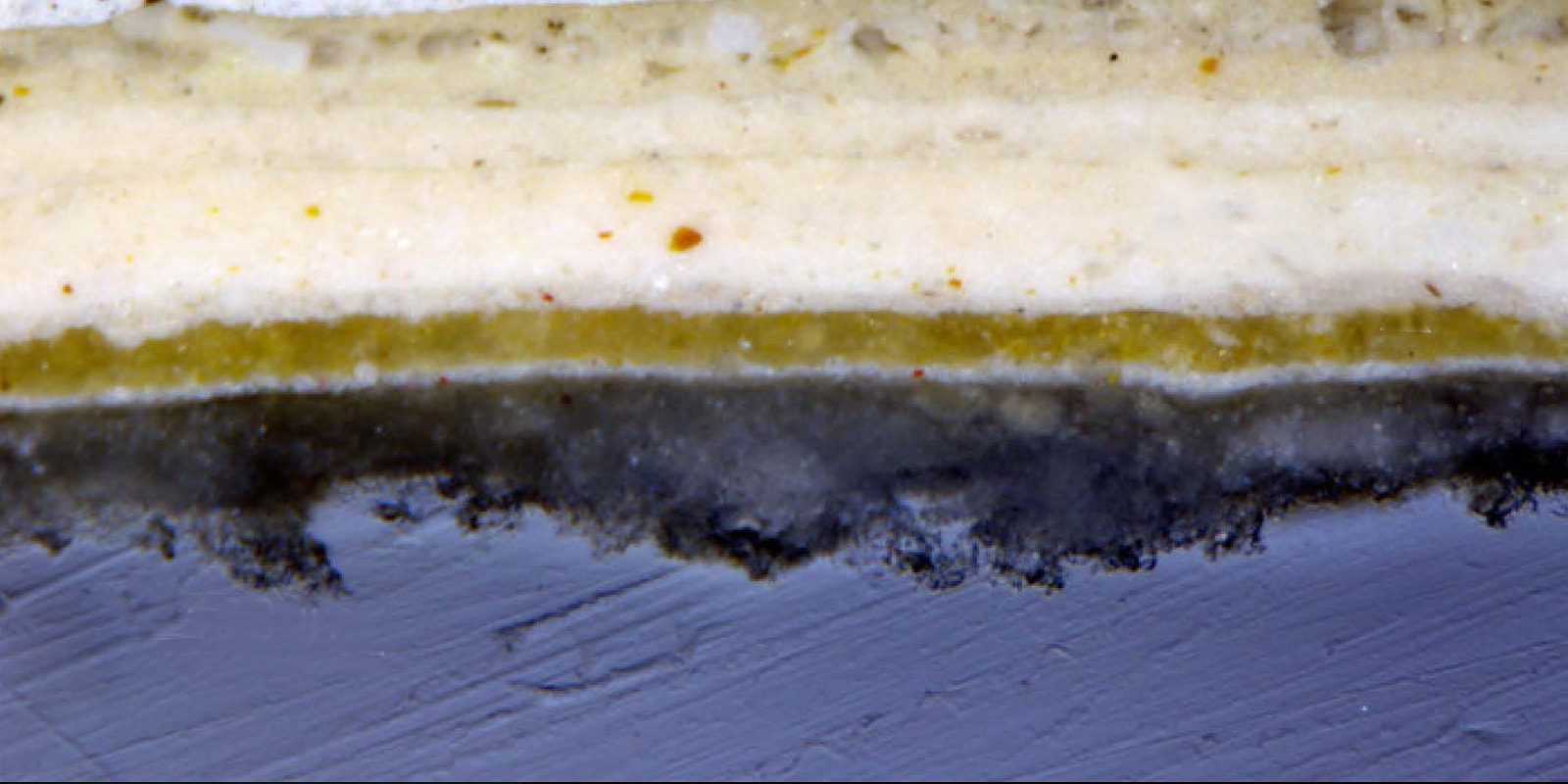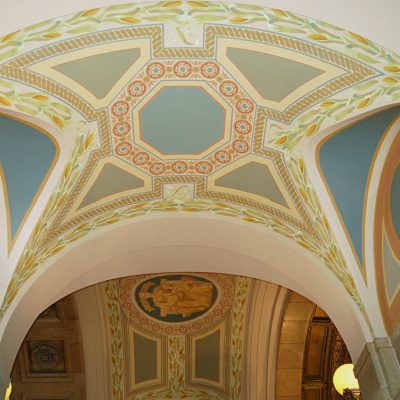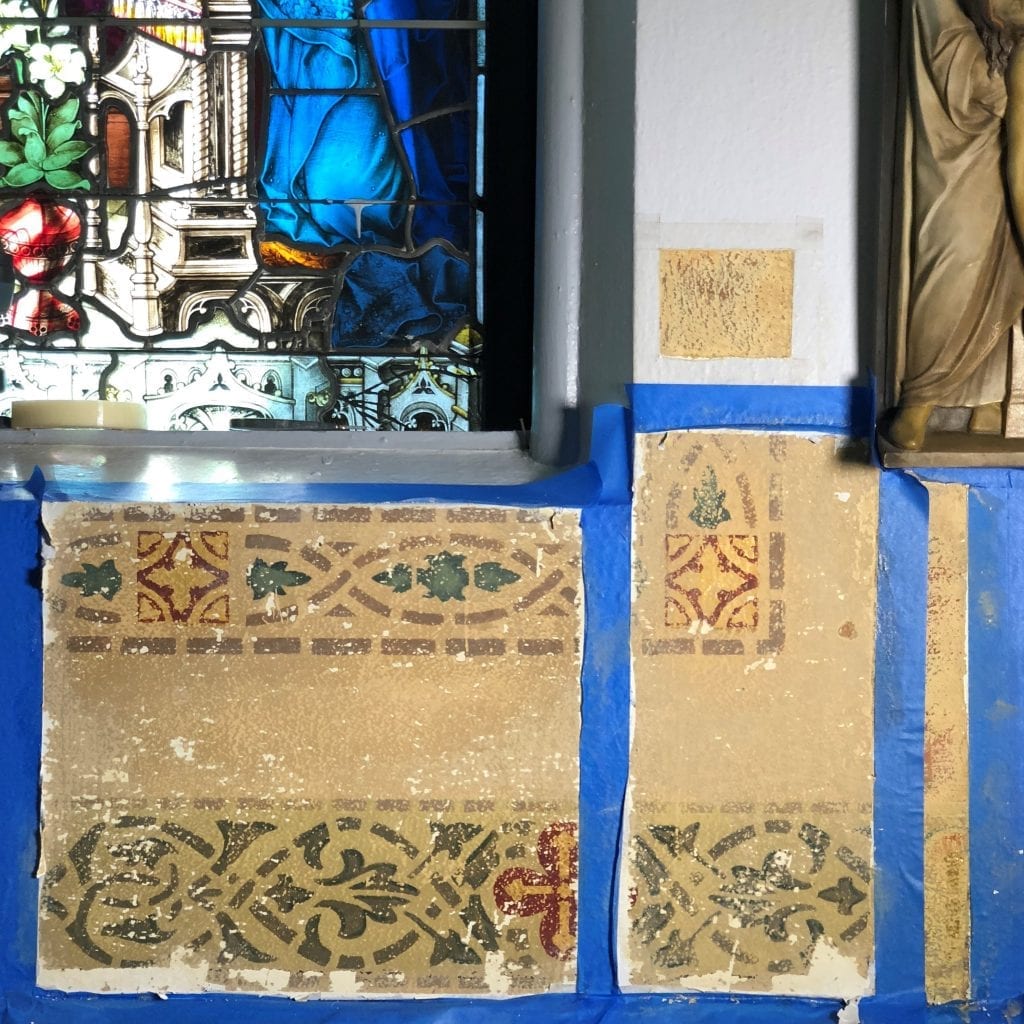When one is working on historic architectural projects, having an understanding of the examination methods that are used during the scientific analysis of complex paint layers can be helpful. One of these methods is paint stratigraphy. Stratigraphic studies is one of the standard methods that are used to extract information about the complex layers of paint and decorative finishes used in a historic structure. Most importantly, stratigraphy helps conservators better understand the history of the paint and the secrets it may hold. This in turn, makes stratigraphy an essential component of any historic paint analysis or finishes investigation.
The Paint Stratigraphy Process
The stratigraphy procedure starts with the gathering of paint samples during the onsite investigation from areas of a structure deemed to be significant by the conservator. Conservators carefully remove paint samples from the defined areas to assure the samples are intact and are a sufficient size to conduct the necessary analysis and investigation.
As shown below, the locations of these samples are notated and the samples are catalogued so that there is no doubt as to where each sample originated. This information will be used to craft the final report and interpretation which will guide any future work, and as such is critical.

Paint analysis sample areas marked
The analysis of the paint samples is conducted using high power microscopes to closely examine the cross sections of the samples. Microscopy of the cross sections, utilizing different types of light (including visible and ultraviolet), is used to show the pigments and layer structures. This examination reveals a wide range of important information, including:
-
- The original paint colors
- Material used in the paint
- Techniques that were used for the decorative finishes (such as whether something is gold paint or metal leaf, and whether or not there is any faux finishing or marbleizing being used)
- Subsequent layers of paint and design campaigns other than the original
In short, paint stratigraphy provides information on the complete history and progression from when the original paint and decorative finishes were applied to the current state. Additionally, information from any dirt or other environmental interferences (like soot) that might have taken place over the years will show up. All the findings that are revealed in this part of the architectural paint analysis gives conservators, architects, and owners a better understanding of the historic building/structure.
The Paint Straigraphy Report
There currently is no standard format for Paint Stratigraphy reports. Different analysts’ reports can vary on the descriptions and details provided, as well as the imagery that is included in the report. That being said, below are a few examples of stratigraphy reports. These examples can give you an idea about what information may be included in a report should you pursue one for your project.
Example 1: Textured Plaster Stratigraphy

This sample shows that the wall has a textured plaster substrate. It shows it is quite different from the fine white plaster of the ceiling, cornice, and cartouches that were also in the building from which the sample was sourced. Also, this sample is representative of the field plaster treatment. There are two layers of translucent yellowish wash (calcimine or distemper) on top of the textured substrate. There is a distinct layer of soot on top of the second-generation yellowish wash. This confirmed it was a left as a finish coat for an extended period of time. The third generation appears to be a translucent white distemper or limewash. After the third generation, the walls were painted with approximately eight generations of paint. The most recent being the yellow paint. This recent yellow paint may have been an attempt to replicate the medium yellow paint observed elsewhere.
Example 2: Flat Plaster Stratigraphy

Top Left View: Normal Light. Bottom Left View: Violet Excitation. Top Right View: Blue excitation only. Top Middle Right: Blue excitation, stained with Alexafluor 488 succinimide in a pH 9.0 Borate buffer (chartreuse fluorescence=positive for proteins). Bottom Middle Right: Green Excitation only. Bottom Right View: Green excitation, stained with Nile Red in ethanol (red-orange fluorescence = positive for drying oils).
This sample, appears to have originally consisted of a light tan emulsion paint on top of plaster. As the layers show, it was additionally prepared with a yellow bole, and decorated with a metallic leaf (now corroded). At some point, these elements have also been additionally painted with the beige paint and metallic powder.
Example 3: Cast Iron Stratigraphy

This sample was taken from a cast iron railing elements that seemed to retain accumulations of early coatings. The flake cross-section microscopy analysis showed there were approximately four generations of paint. The beginning two generations are of a silvery-black or silvery-dark gray metallic paint. In the cross-section, under reflected ultraviolet light, it is possible to see the silvery metal flakes. The metal flakes in the first (earliest) layer are larger and more irregularly dispersed than in the second generation. There is a thick light gray paint layer in the third generation. The uppermost, fourth generation coating is a dark gray, resinous paint.
Example 4: Comparison of Paint Stratigraphies
In this example, paint stratigraphies illustrate the results of an extensive cross-section analysis for a variety of sample from elements within a single structure. The comparative cross-section images show how the first, second and third generations of coatings can be aligned in each sample. The differences that may exist between different areas within the same structure are also shown.
An Important Part of the Paint Analysis Process
Paint stratigraphy is a key component in historic preservation and conservation of architectural structures. By utilizing paint stratigraphy we can examine the layers of paint and discover the hidden treasures of original art work and decoration from the past. This in turn will give us a solid understanding of the paint’s history. As a result, having this information allows us to determine how best we can conserve, restore, replicate and reinstate the true historic fabric of a structure. If you find yourself in need of help when it comes to a historic paint analysis and finishes investigation study, with over 45 years of experience behind us we are always happy to assist.














